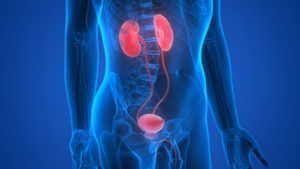 Urology refers to an area of medicine that specializes in the male and female urinary tract, and the male reproductive organs.
Urology refers to an area of medicine that specializes in the male and female urinary tract, and the male reproductive organs.
The Urinary System
The urinary system consists of six organs: two kidneys, two ureters, the urinary bladder, and the urethra.
The kidneys: The primary role of the kidneys is the filtering of blood and the elimination of waste and toxic substances, but they also serve several other functions including:
- Regulation of blood pressure
- Control of electrolyte balance
- Secretion of the hormone responsible for red blood cell production
- Collaboration with the lungs in regulating the PH balance of body fluids
- Synthesis of the hormone calcitriol which helps the kidneys maintain blood calcium levels and promotes the formation of bone
The Ureters: The tubes responsible for carrying urine from the kidneys to the urinary bladder.
The Urinary Bladder: The muscular sac that collects and holds urine until it is excreted.
The Urethra: The tube that carries urine out of the body. These organs are present in both men and women, but, as mentioned above, urology also encompasses the male reproductive organs.
There are many disorders and diseases that can affect the organs and tissues of the urinary system. Some of these include:
- Cancers of the urinary system & male reproductive system
- Bladder infections (cystitis)
- Enlarged prostate – Part of the male reproductive system, an enlarged prostate can make it difficult to empty the bladder.
- Incontinence
- Kidney infections
- Kidney stones
Ultrasound can be a very useful and effective tool for detecting abnormalities and cancers of the urinary system.Signs/symptoms that may indicate a problem with the urinary system include:
- Pain or burning with urination (dysuria)
- Foul-smelling urine
- Abdominal, pelvic or back pain that can be severe
- Abdominal cramping
- Bloody or pink-colored urine (hematuria)
- Cloudy urine
- Fever and chills
- Frequent urination
- Leaking of urine
- Pain during sexual intercourse
- Unexplained weight loss
- Urgent need to urinate
As with any medical problem, early detection and intervention is extremely important.
Ultrasound
Ultrasound is a safe, painless, non-invasive method of ruling out, or discovering the presence of disease using sound. In an ultrasound screening, a technician uses a small probe called a transducer and gel placed directly on the skin. High-frequency sound waves travel from the probe through the gel and into the body. The probe collects the sounds that bounce back, and a computer uses those sound waves to create an image. This safe, and effective tool can help with the diagnosis of multiple conditions related to the tissues and organs of the body.
Doctors can use ultrasound to diagnose conditions such as:
Tumors and cysts – An ultrasound can find dense areas of tissue such as tumors or cysts. It shows cysts differently from tumors to help your doctor make a diagnosis.
Cardiovascular issues – Ultrasound can be used to find narrowed blood vessels, blockages to blood flow, or weakened, ballooning areas of the arteries (aneurism).
Infections – Ultrasound can detect the increase in blood flow that often occurs in areas where the infection is present.
Thyroid conditions – Ultrasound can be used to detect thyroid issues such as growths or abnormal activity.
Uterine fibroids – Detection of fibroids (non-cancerous growths in the uterus) and other conditions related to the female reproductive system show up on the ultrasound. An ultrasound can help doctors find the source of pelvic pain and abnormal bleeding.
Monitor Pregnancy – Perhaps the most well-known use of ultrasound, a fetal ultrasound (sonogram) allows a healthcare provider to evaluate a baby’s growth and development and detect possible problems. Abnormalities in size or shape of virtually any organ or tissue of the body Unlike CT scans and x-rays, there is no potentially harmful radiation exposure involved in an ultrasound. Because of its safe, effective, painless, non-invasive nature, ultrasound screenings should be a part of everyone’s regular physical examination schedule.
Please have your screening done as soon as possible.
